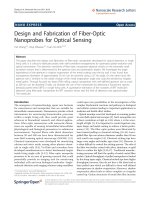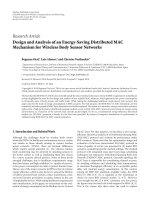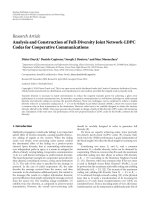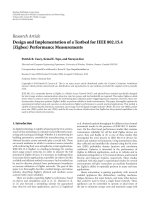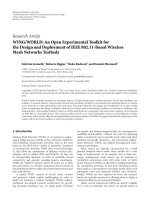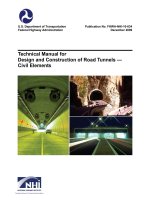Technical manual for design and construction of road tunnels civil elements
Bạn đang xem bản rút gọn của tài liệu. Xem và tải ngay bản đầy đủ của tài liệu tại đây (31.09 MB, 702 trang )
Technical Manual for
Design and Construction of Road Tunnels —
Civil Elements
Publication No. FHWA-NHI-10-034
December 2009
U.S. Department of Transportation
Federal Highway Administration
NOTICE
The contents of this report reflect the views of the authors, who are responsible for
the facts and the accuracy of the data presented herein. The contents do not
necessarily reflect policy of the Department of Transportation. This report does not
constitute a standard, specification, or regulation. The United States Government
does not endorse products or manufacturers. Trade or manufacturer's names
appear herein only because they are considered essential to the objective of this
document.
Technical Report Documentation Page
1. Report No.
2. Government Accession No. 3. Recipient’s Catalog No.
FHWA-NHI-10-034
4. Title and Subtitle 5. Report Date
December 2009
6. Performing Organization Code
TECHNICAL MANUAL FOR
DESIGN AND CONSTRUCTION OF ROAD TUNNELS –
CIVIL ELEMENTS
7. Author(s)
8. Performing Organization Report No.
Principal Investigators:
C. Jeremy Hung, PE, James Monsees, PhD, PE, Nasri Munfah,
PE, and John Wisniewski, PE
9. Performing Organization Name and Address 10. Work Unit No. (TRAIS)
11. Contract or Grant No.
Parsons Brinckerhoff, Inc.
One Penn Plaza, New York, NY 10119
DTFH61-06-T-07-001
12. Sponsoring Agency Name and Address 13. Type of Report and Period Covered
14. Sponsoring Agency Code
National Highway Institute
U.S. Department of Transportation
Federal Highway Administration, Washington, D.C. 20590
15. Supplementary Notes
FHWA COTR – Louisa Ward/ Larry Jones
FHWA Task Manager – Firas I. Sheikh Ibrahim, PhD, PE
FHWA Technical Reviewers – Jesús M. Rohena y Correa, PE; Jerry A. DiMaggio, PE; Steven Ernst,
PE; and Peter Osborn, PE.
See Acknowledgement for List of Authors and Additional Technical Reviewers
16. Abstract
The increased use of underground space for transportation systems and the increasing complexity and
constraints of constructing and maintaining above ground transportation infrastructure have prompted the
need to develop this technical manual. This FHWA manual is intended to be a single-source technical
manual providing guidelines for planning, design, construction and rehabilitation of road tunnels, and
encompasses various types of road tunnels including mined, bored, cut-and-cover, immersed, and jacked
box tunnels. The scope of the manual is primarily limited to the civil elements of road tunnels.
The development of this technical manual has been funded by the National Highway Institute, and
supported by Parsons Brinckerhoff, as well as numerous authors and reviewers.
17. Key Words
18. Distribution Statement
Road tunnel, highway tunnel, geotechnical investigation,
geotechnical baseline report, cut-and-cover tunnel, drill-and-
blast, mined tunnel, bored tunnel, rock tunneling, soft ground
tunneling, sequential excavation method (SEM), immersed
tunnel, jacked box tunnel, seismic consideration,
instrumentation, risk management, rehabilitation.
No restrictions.
19. Security Classif. (of this report)
20. Security Classif. (of this page) 21. No. of Pages
22. Price
UNCLASSIFIED
UNCLASSIFIED
702
Form DOT F 1700.7(8-72) Reproduction of completed page authorized
CONVERSION FACTORS
Approximate Conversions to SI Units
Approximate Conversions from SI Units
When you know
Multiply by
To find
When you know
Multiply by
To find
(a) Length
inch
25.4
millimeter
millimeter
0.039
inch
foot 0.305 meter meter 3.28 foot
yard 0.914 meter meter 1.09 yard
mile 1.61 kilometer kilometer 0.621 mile
(b) Area
square inches
645.2
square millimeters
square millimeters
0.0016
square inches
square feet 0.093 square meters square meters 10.764 square feet
acres 0.405 hectares hectares 2.47 acres
square miles 2.59 square kilometers square kilometers 0.386 square miles
(c) Volume
fluid ounces
29.57
milliliters
milliliters
0.034
fluid ounces
gallons 3.785 liters liters 0.264 gallons
cubic feet 0.028 cubic meters cubic meters 35.32 cubic feet
cubic yards 0.765 cubic meters cubic meters 1.308 cubic yards
(d) Mass
ounces
28.35
grams
grams
0.035
ounces
pounds 0.454 kilograms kilograms 2.205 pounds
short tons (2000 lb) 0.907 megagrams (tonne) megagrams (tonne) 1.102 short tons (2000 lb)
(e) Force
pound
4.448
Newton
Newton
0.2248
pound
(f) Pressure, Stress, Modulus of Elasticity
pounds per square foot 47.88 Pascals Pascals 0.021 pounds per square foot
pounds per square inch 6.895 kiloPascals kiloPascals 0.145 pounds per square inch
(g) Density
pounds per cubic foot 16.019 kilograms per cubic meter kilograms per cubic meter 0.0624 pounds per cubic feet
(h) Temperature
Fahrenheit temperature(
o
F)
5/9(
o
F- 32)
Celsius temperature(
o
C)
Celsius temperature(
o
C)
9/5(
o
C)+ 32
Fahrenheit temperature(
o
F)
Notes: 1) The primary metric (SI) units used in civil engineering are meter (m), kilogram (kg), second(s), newton (N) and pascal (Pa=N/m
2
).
2) In a "soft" conversion, an English measurement is mathematically converted to its exact metric equivalent.
3) In a "hard" conversion, a new rounded metric number is created that is convenient to work with and remember.
FOREWORD
The FHWA Technical Manual for Design and Construction of Road Tunnels
– Civil Elements has been published to provide guidelines and
recommendations for planning, design, construction and structural
rehabilitation and repair of the civil elements of road tunnels, including cut-
and-cover tunnels, mined and bored tunnels, immersed tunnels and jacked
box tunnels. The latest edition of the AASHTO LRFD Bridge Design and
Construction Specifications are used to the greatest extent applicable in the
design examples. This manual focuses primarily on the civil elements of
design and construction of road tunnels. It is the intent of FHWA to
collaborate with AASHTO to further develop manuals for the design and
construction of other key tunnel elements, such as, ventilation, lighting, fire
life safety, mechanical, electrical and control systems.
FHWA intends to work with road tunnel owners in developing a manual on
the maintenance, operation and inspection of road tunnels. This manual is
expected to expand on the two currently available FHWA publications: (1)
Highway and Rail Transit Tunnel Inspection Manual and (2) Highway and
Rail Transit Tunnel Maintenance and Rehabilitation Manual.
M. Myint Lwin, Director
Office of Bridge Technology
This page is intentionally left blank.
FHWA-NHI-09-010 Preface
Road Tunnel Manual P-1 March 2009
PREFACE
The increased use of underground space for transportation systems and the increasing complexity and
constraints of constructing and maintaining above ground transportation infrastructure have prompted the
need to develop this technical manual. This FHWA manual is intended to be a single-source technical
manual providing guidelines for planning, design, construction and rehabilitation of road tunnels, and
encompasses various types of tunnels including mined and bored tunnels (Chapters 6-10), cut-and-cover
tunnels (Chapter 5), immersed tunnels (Chapter 11), and jacked box tunnels (Chapter 12).
The scope of the manual is primarily limited to the civil elements of design and construction of road
tunnels. FHWA intended to develop a separate manual to address in details the design and construction
issues of the system elements of road tunnels including fire life safety, ventilation, lighting, drainage,
finishes, etc. This manual therefore only provides limited guidance on the system elements when
appropriate.
Accordingly, the manual is organized as presented below.
Chapter 1 is an introductory chapter and provides general overview of the planning process of a road
tunnel project including alternative route study, tunnel type study, operation and financial planning, and
risk analysis and management.
Chapter 2 provides the geometrical requirements and recommendations of new road tunnels including
horizontal and vertical alignments and tunnel cross section requirements.
Chapter 3 covers the geotechnical investigative techniques and parameters required for planning, design
and construction of road tunnels. In addition to subsurface investigations, this chapter also addresses in
brief information study; survey; site reconnaissance, geologic mapping, instrumentation, and other
investigations made during and after construction.
Chapter 4 discusses the common types of geotechnical reports required for planning, design and
construction of road tunnels including: Geotechnical Data Report (GDR) which presents all the factual
geotechnical data; Geotechnical Design Memorandum (GDM) which presents interpretations of the
geotechnical data and other information used to develop the designs; and Geotechnical Baseline Report
(GBR) which defines the baseline conditions on which contractors will base their bids upon.
Chapter 5 presents the construction methodology and excavation support systems for cut-and-cover road
tunnels, describes the structural design in accordance with the AASHTO LRFD Bridge Design
Specifications, and discusses various other design issues. A design example is included in Appendix C.
Chapters 6 through 10 present design recommendations and requirements for mined and bored road
tunnels.
Chapters 6 and 7 present mined/bored tunneling issues in rock and soft ground, respectively. They
present various excavation methods and temporary support elements and focus on the selection of
temporary support of excavation and input for permanent lining design. Appendix D presents common
types of rock and soft ground tunnel boring machines (TBM).
Chapter 8 addresses the investigation, design, construction and instrumentation concerns and issues for
mining and boring in difficult ground conditions including: mixed face tunneling; high groundwater
pressure and inflow; unstable ground such as running sands, sensitive clays, faults and shear zones, etc.;
squeezing ground; swelling ground; and gassy ground.
FHWA-NHI-09-010 Preface
Road Tunnel Manual P-2 March 2009
Chapter 9 introduces the history, principles, and recent development of mined tunneling using Sequential
Excavation Method (SEM), as commonly known as the New Austrian Tunneling Method (NATM). This
chapter focuses on the analysis, design and construction issues for SEM tunneling.
Chapter 10 discusses permanent lining structural design and detailing for mined and bored tunnels based
on LRFD methodology, and presents overall processes for design and construction of permanent tunnel
lining. It encompasses various structural systems used for permanent linings including cast-in-place
concrete lining, precast concrete segmental lining, steel line plate lining and shotcrete lining. A design
example is presented in Appendix G.
Chapter 11 discusses immersed tunnel design and construction. It identifies various immersed tunnel
types and their construction techniques. It also addresses the structural design approach and provides
insights on the construction methodologies including fabrication, transportation, placement, joining and
backfilling. It addresses the tunnel elements water tightness and the trench stability and foundation
preparation requirements.
Chapter 12 presents jacked box tunneling, a unique tunneling method for constructing shallow
rectangular road tunnels beneath critical facilities such as operating railways, major highways and airport
runways without disruption of the services provided by these surface facilities or having to relocate them
temporarily to accommodate open excavations for cut and cover construction.
Chapter 13 provides general procedure for seismic design and analysis of tunnel structures, which are
based primarily on the ground deformation approach (as opposed to the inertial force approach); i.e., the
structures should be designed to accommodate the deformations imposed by the ground.
Chapter 14 discusses tunnel construction engineering issues, i.e., the engineering that must go into a road
tunnel project to make it constructible. This chapter examines various issues that need be engineered
during the design process including project cost drivers; construction staging and sequencing; health and
safety issues; muck transportation and disposal; and risk management and dispute resolution.
Chapter 15 presents the typical geotechnical and structural instrumentation for monitoring: 1), ground
movement away from the tunnel; 2), building movement for structures within the zone of influence; 3),
tunnel movement of the tunnel being constructed or adjacent tubes; 4), dynamic ground motion from drill
& blast operation, and 5), groundwater movement due to changes in the water percolation pattern.
Lastly, Chapter 16 focuses on the identification, characterization and rehabilitation of structural defects
in a tunnel system.
FHWA-NHI-09-010 Acknowledgments
Road Tunnel Manual P-3 March 2009
ACKNOWLEDGMENTS
The development of this manual has been funded by the National Highway Institute, and supported by
Parsons Brinckerhoff, as well as numerous authors and reviewers acknowledged hereafter including the
following primary authors from Parsons Brinckerhoff (PB), and Gall Zeidler Consultants, LLC:
Chapter 1 Planning -Nasri Munfah/ Christian Ingerslev
Chapter 2 Geometrical Configuration - Christian Ingerslev/ Jeremy Hung
Chapter 3 Geotechnical Investigation - Jeremy Hung/ Raymond Castelli
Chapter 4 Geotechnical Report - Raymond Castelli/ Jeremy Hung
Chapter 5 Cut-and-Cover Tunnels - John Wisniewski/ Nasri Munfah
Chapter 6 Rock Tunneling – James Monsees/ Sunghoon Choi
Chapter 7 Soft Ground Tunneling – James Monsees
Chapter 8 Difficult Ground Tunneling – James Monsees/ Terrence McCusker (Consultant)
Chapter 9 Sequential Excavation Method - Vojtech Gall/Kurt Zeidler
Chapter 10 Tunneling Lining - John Wisniewski
Chapter 11 Immersed Tunnels - Christian Ingerslev/Nasri Munfah
Chapter 12 Jacked Box Tunneling - Philip Rice/ Jeremy Hung
Chapter 13 Seismic Considerations – Jaw-Nan (Joe) Wang
Chapter 14 Construction Engineering - Thomas Peyton
Chapter 15 Geotechnical and Structural Instrumentation – Charles Daugherty, and
Chapter 16 Tunnel Rehabilitation - Henry Russell
The Principal Investigators would like to especially acknowledge the support of the FHWA Task Manger,
Firas Ibrahim, and the reviews and recommendations provided by the FHWA technical reviewers
including Jesus Rohena, Jerry DiMaggio, Steven Ernst and Peter Osborn. Furthermore, the reviews and
contributions of the following members of AASHTO T-20 Tunnel Committee are also acknowledged:
• Kevin Thompson, Chair, Caltrans
• Bruce Johnson, Vice Chair, Oregon DOT
• Donald Dwyer, New York State DOT
• Louis Ruzzi, Pennsylvania DOT
• Prasad Nallapaneni, Virginia DOT
• Michael Salamon, Colorado DOT
• Bijan Khaleghi, Washington DOT
• Alexander Bardow, Massachusetts Highway Department
• Dharam Pal, The Port Authority of New York and New Jersey
• Moe Amini, Caltrans, and
• Harry Capers, Arora and Associates, P.C.
The Principal Investigators and authors would like to express our special thanks to Dr. George Munfakh
of PB for his continuing support, advice and encouragement.
FHWA-NHI-09-010 Acknowledgments
Road Tunnel Manual P-4 March 2009
We further acknowledge the support of Gene McCormick of PB, and the contributions and reviews from
Sunghoon Choi, Joe O’Carroll, Doug Anderson, Kyle Ott, Frank Pepe, and Bill Hansmire of PB, Dr.
Andrzej Nowak of University of Nebraska, and Tony Ricci and Nabil Hourani of MassHighway.
Chapter 8 is an update of the Chapter 8 “Tunneling in Difficult Ground” of the 2
nd
Edition Tunnel
Engineering Handbook authored by Terrence G. McCusker (Bickel, et al., 1996). The Principal
Investigators appreciate PB for providing the original manuscript for the chapter.
In addition, we appreciate the information provided by Herrenknecht AG, the Robbins Company, and
several other manufacturers and contractors from the tunneling industry.
Lastly, the Principal Investigators and authors would like to extend our gratitude to the supports provided
by a number of professionals from PB and Gall Zeidler Consultants, LLC. including Taehyun Moon,
Kevin Doherty, Mitchell Fong, Rudy Holley, Benny Louie, Tim O’Brien and Dominic Reda for their
assistance; Jose Morales and Jeff Waclawski for graphic support, and finally Amy Pavlakovich, Lauren
Chu, Alejandra Morales, Mary Halliburton, and Maria Roberts for their assistance and overall word
processing and compiling.
FHWA-NHI-09-010 Table of Contents
Road Tunnel Manual i March 2009
TABLE OF CONTENTS
LIST OF FIGURES xiv
LIST OF TABLES xxi
CHAPTER 1 - PLANNING 1-1
1.1 INTRODUCTION 1-1
1.1.1 Tunnel Shape and Internal Elements 1-2
1.1.2 Classes of Roads and Vehicle Sizes 1-4
1.1.3 Traffic Capacity 1-5
1.2 ALTERNATIVE ANALYSES 1-6
1.2.1 Route Studies 1-6
1.2.2 Financial Studies 1-6
1.2.3 Types of Road Tunnels 1-7
1.2.4 Geotechnical Investigations 1-9
1.2.5 Environmental and Community Issues 1-10
1.2.6 Operational Issues 1-11
1.2.7 Sustainability 1-11
1.3 TUNNEL TYPE STUDIES 1-11
1.3.1 General Description of Various Tunnel Types 1-11
1.3.2 Design Process 1-13
1.3.3 Tunnel Cross-Section 1-13
1.3.4 Groundwater Control 1-13
1.3.5 Tunnel Portals 1-15
1.3.6 Fire-Life Safety Systems 1-15
1.3.7 Tunnel Drainage 1-18
1.4 OPERATIONAL AND FINANCIAL PLANNING 1-18
1.4.1 Potential Funding Sources and Cash Flow Requirements 1-18
1.4.2 Conceptual Level Cost Analysis 1-19
1.4.3 Project Delivery Methods 1-19
1.4.4 Operation and Maintenance Cost Planning 1-21
1.5 RISK ANALYSIS AND MANAGEMENT 1-21
CHAPTER 2 - GEOMETRIC CONFIGURATION 2-1
2.1 INTRODUCTION 2-1
2.1.1 Design Standards 2-2
2.2 HORIZONTAL AND VERTICAL ALIGNMENTS 2-2
2.2.1 Maximum Grades 2-3
FHWA-NHI-09-010 Table of Contents
Road Tunnel Manual ii March 2009
2.2.2 Horizontal and Vertical Curves 2-3
2.2.3 Sight and Braking Distance Requirements 2-3
2.2.4 Other Considerations 2-3
2.3 TRAVEL CLEARANCE 2-4
2.4 CROSS SECTION ELEMENTS 2-6
2.4.1 Typical Cross Section Elements 2-6
2.4.2 Travel Lane and Shoulder 2-8
2.4.3 Sidewalks/Emergency Egress Walkway 2-8
2.4.4 Tunnel Drainage Requirements 2-9
2.4.5 Ventilation Requirements 2-9
2.4.6 Lighting Requirements 2-11
2.4.7 Traffic Control Requirements 2-11
2.4.8 Portals and Approach 2-12
CHAPTER 3 - GEOTECHNICAL INVESTIGATIONS 3-1
3.1 INTRODUCTION 3-1
3.1.1 Phasing of Geotechnical Investigations 3-1
3.2 INFORMATION STUDY 3-3
3.2.1 Collection and Review of Available Information 3-3
3.2.2 Topographical Data 3-4
3.3 SURVEYS AND SITE RECONNAISSANCE 3-4
3.3.1 Site Reconnaissance and Preliminary Surveys 3-4
3.3.2 Topographic Surveys 3-6
3.3.3 Hydrographical Surveys 3-7
3.3.4 Utility Surveys 3-8
3.3.5 Identification of Underground Structures and Other Obstacles 3-8
3.3.6 Structure Preconstruction Survey 3-9
3.4 GEOLOGIC MAPPING 3-9
3.5 SUBSURFACE INVESTIGATIONS 3-10
3.5.1 General 3-10
3.5.2 Test Borings and Sampling 3-15
3.5.3 Soil and Rock Identification and Classification 3-19
3.5.4 Field Testing Techniques (Pre-Construction) 3-21
3.5.5 Laboratory Testing 3-29
3.5.6 Groundwater Investigation 3-31
3.6 ENVIRONMENTAL ISSUES 3-33
3.7 SEISMICITY 3-34
3.8 ADDITIONAL INVESTIGATIONS DURING CONSTRUCTION 3-35
FHWA-NHI-09-010 Table of Contents
Road Tunnel Manual iii March 2009
3.8.1 General 3-35
3.8.2 Geologic Face Mapping 3-36
3.8.3 Geotechnical Instrumentation 3-36
3.8.4 Probing 3-37
3.8.5 Pilot Tunnels 3-37
3.9 GEOSPATIAL DATA MANAGEMENT SYSTEM 3-38
CHAPTER 4 - GEOTECHNICAL REPORTS 4-1
4.1 INTRODUCTION 4-1
4.2 GEOTECHNICAL DATA REPORT 4-2
4.3 GEOTECHNICAL DESIGN MEMORANDUM 4-5
4.4 GEOTECHNICAL BASELINE REPORT 4-8
4.4.1 Purpose and Objective 4-8
4.4.2 General Considerations 4-9
4.4.3 Guidelines for Preparing a GBR 4-10
CHAPTER 5 - CUT AND COVER TUNNELS 5-1
5.1 INTRODUCTION 5-1
5.2 CONSTRUCTION METHODOLOGY 5-1
5.2.1 General 5-1
5.2.2 Conventional Bottom-Up Construction 5-2
5.2.3 Top-Down Construction 5-3
5.2.4 Selection 5-4
5.3 SUPPORT OF EXCAVATION 5-5
5.3.1 General 5-5
5.3.2 Temporary Support of Excavation 5-6
5.3.3 Permanent Support of Excavation 5-8
5.3.4 Ground Movement and Impact on Adjoining Structures 5-11
5.3.5 Base Stability 5-12
5.4 STRUCTURAL SYSTEMS 5-12
5.4.1 General 5-12
5.4.2 Structural Framing 5-13
5.4.3 Materials 5-13
5.4.4 Buoyancy 5-16
5.4.5 Expansion and Contraction Joints 5-16
5.4.6 Waterproofing 5-17
5.5 LOADS 5-17
5.5.1 General 5-17
FHWA-NHI-09-010 Table of Contents
Road Tunnel Manual iv March 2009
5.5.2 Load Combinations 5-20
5.6 STRUCTURAL DESIGN 5-24
5.6.1 General 5-24
5.6.2 Structural Analysis 5-25
5.7 GROUNDWATER CONTROL 5-26
5.7.1 Construction Dewatering 5-26
5.7.2 Methods of Dewatering and Their Typical Applications 5-27
5.7.3 Uplift Pressures and Mitigation Measures 5-27
5.7.4 Piping and Base Stability 5-27
5.7.5 Potential Impact of Area Dewatering 5-28
5.7.6 Groundwater Discharge and Environmental Issues 5-28
5.8 MAINTENANCE AND PROTECTION OF TRAFFIC 5-28
5.9 UTILITY RELOCATION AND SUPPORT 5-28
5.9.1 Types of Utilities 5-28
5.9.2 General Approach to Utilities During Construction 5-30
CHAPTER 6 - ROCK TUNNELING 6-1
6.1 INTRODUCTION 6-1
6.2 ROCK FAILURE MECHANISM 6-1
6.2.1 Wedge Failure 6-2
6.2.2 Stress Induced Failure 6-3
6.2.3 Squeezing and Swelling 6-4
6.3 ROCK MASS CLASSIFICATIONS 6-5
6.3.1 Introduction 6-5
6.3.2 Terzaghi’s Classification 6-5
6.3.3 RQD 6-6
6.3.4 Q System 6-6
6.3.5 Rock Mass Rating (RMR) System 6-10
6.3.6 Estimation of Rock Mass Deformation Modulus Using Rock Mass Classification 6-12
6.4 ROCK TUNNELING METHODS 6-13
6.4.1 Drill and Blast 6-13
6.4.2 Tunnel Boring Machines (TBM) 6-18
6.4.3 Roadheaders 6-23
6.4.4 Other Mechanized Excavation Methods 6-24
6.4.5 Sequential Excavation Method (SEM)/ New Austrian Tunneling Method (NATM) 6-24
6.5 TYPES OF ROCK REINFORCEMENT AND EXCAVATION SUPPORT 6-24
6.5.1 Excavation Support Options 6-24
6.5.2 Rock Bolts 6-25
FHWA-NHI-09-010 Table of Contents
Road Tunnel Manual v March 2009
6.5.3 Ribs and Lagging 6-29
6.5.4 Shotcrete 6-29
6.5.5 Lattice Girder 6-30
6.5.6 Spiles and Forepoles 6-31
6.5.7 Precast Segment Lining 6-31
6.6 DESIGN AND EVALUATION OF TUNNEL SUPPORTS 6-32
6.6.1 Empirical Method 6-33
6.6.2 Analytical Methods 6-39
6.6.3 Numerical Methods 6-43
6.6.4 Pre-Support and Other Ground Improvement Methods 6-47
6.6.5 Sequencing of Excavation and Initial Support Installation 6-48
6.6.6 Face Stability 6-49
6.6.7 Surface Support 6-49
6.6.8 Ground Displacements 6-49
6.7 GROUNDWATER CONTROL DURING EXCAVATION 6-50
6.7.1 Dewatering at the Tunnel Face 6-50
6.7.2 Drainage Ahead of Face from Probe Holes 6-51
6.7.3 Drainage from Pilot Bore/Tunnel 6-51
6.7.4 Grouting 6-51
6.7.5 Freezing 6-52
6.7.6 Closed Face Machine 6-52
6.7.7 Other Measures of Groundwater Control 6-52
6.8 PERMANENT LINING DESIGN ISSUES 6-53
6.8.1 Introduction 6-53
6.8.2 Rock Load Considerations 6-53
6.8.3 Groundwater Load Considerations 6-55
6.8.4 Drained Versus Undrained System 6-59
6.8.5 Uplift Condition 6-60
6.8.6 Waterproofing 6-61
CHAPTER 7 - SOFTGROUND TUNNELING 7-1
7.1 INTRODUCTION 7-1
7.2 GROUND BEHAVIOR 7-1
7.2.1 Soft Ground Classification 7-1
7.2.2 Changes of Equilibrium during Construction 7-3
7.2.3 The Influence of the Support System on Equilibrium Conditions 7-5
7.3 EXCAVATION METHODS 7-6
7.3.1 Shield Tunneling 7-6
7.3.2 Earth Pressure Balance and Slurry Face Shield Tunnel Boring Machines 7-8
FHWA-NHI-09-010 Table of Contents
Road Tunnel Manual vi March 2009
7.3.3 Choosing between Earth Pressure Balance Machines and Slurry Tunneling Machines 7-12
7.3.4 Sequential Excavation Method (SEM) 7-14
7.4 GROUND LOADS AND ground-SUPPORT interaction 7-15
7.4.1 Introduction 7-15
7.4.2 Loads for Initial Tunnel Supports 7-16
7.4.3 Analytical Solutions for Ground-Support Interaction 7-17
7.4.4 Numerical Methods 7-17
7.5 TUNNELING INDUCED SETTLEMENT 7-18
7.5.1 Introduction 7-18
7.5.2 Sources of Settlement 7-18
7.5.3 Settlement Calculations 7-19
7.6 IMPACT ON AND PROTECTION OF SURFACE FACILITIES 7-23
7.6.1 Evaluation of Structure Tolerance to Settlement 7-23
7.6.2 Mitigating Settlement 7-24
7.6.3 Structure Protection 7-25
7.7 SOIL STABILIZATION AND IMPROVEMENT 7-25
7.7.1 Purpose 7-25
7.7.2 Typical Applications 7-25
7.7.3 Reinforcement Methods 7-26
7.7.4 Micropiles 7-27
7.7.5 Grouting Methods 7-27
7.7.6 Ground Freezing 7-28
CHAPTER 8 - DIFFICULT GROUND TUNNELING 8-1
8.1 INTRODUCTION 8-1
8.1.1 Instability 8-1
8.1.2 Heavy Loading 8-1
8.1.3 Obstacles and Constraints 8-1
8.1.4 Physical Conditions 8-2
8.2 INSTABILITY 8-2
8.2.1 Non-Cohesive Sand and Gravel 8-2
8.2.2 Soft Clay 8-4
8.2.3 Blocky Rock 8-5
8.2.4 Adverse Combinations of Joints and Shears 8-6
8.2.5 Faults and Alteration Zones 8-7
8.2.6 Water 8-8
8.2.7 Mixed Face Tunneling 8-8
8.3 HEAVING LOADING 8-10
8.3.1 Squeezing Rock 8-10
FHWA-NHI-09-010 Table of Contents
Road Tunnel Manual vii March 2009
8.3.2 The Squeezing Process 8-10
8.3.3 Yielding Supports 8-12
8.3.4 TBM Tunneling 8-14
8.3.5 Steel Rib Support System 8-15
8.3.6 Concrete Segments 8-16
8.3.7 TBM Tunneling System 8-16
8.3.8 Operational Flexibility 8-18
8.3.9 Swelling 8-18
8.3.10 Swelling Mechanism 8-18
8.3.11 Other Rock Problems 8-18
8.4 OBSTACLES AND CONSTRAINTS 8-19
8.4.1 Boulders 8-19
8.4.2 Karstic Limestone 8-19
8.4.3 Abandoned Foundations 8-20
8.4.4 Shallow Tunnels 8-20
8.5 PHYSICAL CONDITIONS 8-21
8.5.1 Methane 8-21
8.5.2 Hydrogen Sulfide 8-21
8.5.3 High Temperatures 8-21
8.5.4 Observations 8-22
CHAPTER 9 - SEQUENTIAL EXCAVATION METHOD 9-1
9.1 INTRODUCTION 9-1
9.2 BACKGROUND AND CONCEPTS 9-2
9.3 SEM REGULAR CROSS SECTION 9-5
9.3.1 Geometry 9-5
9.3.2 Dual Lining 9-6
9.3.3 Initial Shotcrete Lining 9-7
9.3.4 Waterproofing 9-7
9.3.5 Final Tunnel Lining 9-9
9.4 GROUND CLASSIFICATION AND SEM EXCAVATION AND SUPPORT CLASSES 9-11
9.4.1 Rock Mass Classification Systems 9-11
9.4.2 Ground Support Systems 9-11
9.4.3 Excavation and Support Classes (ESC) and Initial Support 9-12
9.4.4 Longitudinal Tunnel Profile and Distribution of Excavation and Support Classes 9-14
9.4.5 Tunnel Excavation, Support, and Pre-Support Measures 9-15
9.4.6 Example SEM Excavation Sequence and Support Classes 9-20
9.4.7 Excavation Methods 9-24
9.5 GROUND SUPPORT ELEMENTS 9-26
FHWA-NHI-09-010 Table of Contents
Road Tunnel Manual viii March 2009
9.5.1 Shotcrete 9-26
9.5.2 Rock Reinforcement 9-30
9.5.3 Lattice Girders and Rolled Steel Sets 9-35
9.5.4 Pre-support Measures and Ground Improvement 9-36
9.5.5 Portals 9-41
9.6 STRUCTURAL DESIGN ISSUES 9-43
9.6.1 Ground-Structure Interaction 9-43
9.6.2 Numerical Modeling 9-44
9.6.3 Considerations for Future Loads 9-48
9.7 INSTRUMENTATION AND MONITORING 9-48
9.7.1 General 9-48
9.7.2 Surface and Subsurface Instrumentation 9-49
9.7.3 Tunnel Instrumentation 9-49
9.7.4 SEM Monitoring Cross Sections 9-50
9.7.5 Interpretation of Monitoring Results 9-50
9.8 CONTRACTUAL ASPECTS 9-52
9.8.1 Contractor Pre-Qualification 9-52
9.8.2 Unit Prices 9-53
9.9 EXPERIENCED PERSONNEL IN DESIGN, CONSTRUCTION, AND CONSTRUCTION
MANAGEMENT 9-53
CHAPTER 10
- TUNNEL LINING 10-1
10.1 INTRODUCTION 10-1
10.1.1 Load and Resistance factor Design (LRFD) 10-3
10.2 DESIGN CONSIDERATIONS 10-4
10.2.1 Lining Stiffness and Deformation 10-4
10.2.2 Constructability Issues 10-4
10.2.3 Durability 10-5
10.2.4 High Density Concrete 10-5
10.2.5 Corrosion Protection 10-5
10.2.6 Lining Joints 10-6
10.3 STRUCTURAL DESIGN 10-6
10.3.1 Loads 10-6
10.3.2 Load Combinations 10-10
10.3.3 Design Criteria 10-10
10.3.4 Structural Analysis 10-13
10.4 CAST-IN-PLACE CONCRETE 10-16
10.4.1 Description 10-16
FHWA-NHI-09-010 Table of Contents
Road Tunnel Manual ix March 2009
10.4.2 Design Considerations 10-18
10.4.3 Materials 10-19
10.4.4 Construction Considerations 10-20
10.5 PRECAST SEGMENTAL LINING 10-20
10.5.1 Description 10-20
10.5.2 Design Considerations 10-22
10.5.3 Materials 10-27
10.5.4 Construction Considerations 10-28
10.6 STEEL PLATE LINING 10-28
10.6.1 Design Considerations 10-30
10.7 SHOTCRETE LINING 10-30
10.8 SELECTING A LINING SYSTEM 10-32
CHAPTER 11 - IMMERSED TUNNELS 11-1
11.1 INTRODUCTION 11-1
11.1.1 Typical Applications 11-2
11.1.2 Types of Immersed Tunnel 11-2
11.1.3 Single Shell Steel Tunnel 11-3
11.1.4 Double Shell 11-4
11.1.5 Sandwich Construction 11-5
11.1.6 Concrete Immersed Tunnels 11-7
11.2 CONSTRUCTION METHODOLOGY 11-8
11.2.1 General 11-8
11.2.2 Trench Excavation 11-9
11.2.3 Foundation Preparation 11-10
11.2.4 Tunnel Element Fabrication 11-11
11.2.5 Transportation and Handling of Tunnel Elements 11-12
11.2.6 Lowering and Placing 11-12
11.2.7 Element Placement 11-14
11.2.8 Backfilling 11-16
11.2.9 Locking Fill 11-16
11.2.10 General Backfill 11-17
11.2.11 Protection Blanket 11-17
11.2.12 Anchor Release Protection 11-17
11.3 LOADINGS 11-17
11.3.1 General 11-17
11.3.2 Loads 11-18
11.3.3 Ship Anchors 11-21
11.3.4 Ship Sinking 11-22
FHWA-NHI-09-010 Table of Contents
Road Tunnel Manual x March 2009
11.3.5 Load Combinations 11-23
11.3.6 Loads during Fabrication, Transportation and Placement 11-24
11.4 STRUCTURAL DESIGN 11-25
11.4.1 General 11-25
11.4.2 Structural Analysis 11-27
11.5 WATERTIGHTNESS AND JOINTS BETWEEN ELEMENTS 11-28
11.5.1 External Waterproofing of Tunnels 11-28
11.5.2 Joints 11-29
11.5.3 Design of Joints between Elements 11-31
CHAPTER 12 - JACKED BOX TUNNELING 12-1
12.1 INTRODUCTION 12-1
12.2 BASIC PRINCIPLES 12-2
12.3 CENTRAL ARTERY/TUNNEL (CA/T) PROJECT JACKED BOX TUNNELS 12-2
12.4 LOAD AND STRUCTURAL CONSIDERATIONS 12-7
12.4.1 Ground Drag Load and Anti-Drag System (ADS) 12-7
12.4.2 Jacking Load 12-8
12.5 GROUND CONTROL 12-10
12.5.1 Ground Freezing for CA/T Project Jacked Tunnels 12-10
12.5.2 Face Loss 12-13
12.5.3 Over Cut 12-13
12.6 OTHER CONSIDERATIONS 12-14
12.6.1 Monitoring 12-14
12.6.2 Vertical Alignment 12-14
12.6.3 Horizontal Alignment 12-14
CHAPTER 13 - SEISMIC CONSIDERATIONS 13-1
13.1 INTRODUCTION 13-1
13.2 DETERMINATION OF SEISMIC ENVIRONMENT 13-1
13.2.1 Earthquake Fundamental 13-1
13.2.2 Ground Motion Hazard Analysis 13-7
13.2.3 Ground Motion Parameters 13-11
13.3 FACTORS THAT INFLUENCE TUNNEL SEISMIC PERFORMANCE 13-14
13.3.1 Seismic Hazard 13-14
13.3.2 Geologic Conditions 13-15
13.3.3 Tunnel Design, Construction, and Condition 13-15
13.4 SEISMIC PERFORMANCE AND SCREENING GUIDELINES OF TUNNELS 13-16
13.4.1 Screening Guidelines Applicable to All Types of Tunnels 13-16
FHWA-NHI-09-010 Table of Contents
Road Tunnel Manual xi March 2009
13.4.2 Additional Screening Guidelines for Bored Tunnels 13-16
13.4.3 Additional Screening Guidelines for Cut-and-Cover Tunnels 13-19
13.4.4 Additional Screening Guidelines for Immersed Tubes 13-21
13.5 SEISMIC EVALUATION PROCEDURES - GROUND SHAKING EFFECTS 13-21
13.5.1 Evaluation of Transverse Ovaling/Racking Response of Tunnel Structures 13-22
13.5.2 Evaluation of Longitudinal Response of Tunnel Structures 13-41
13.5.2.2 Procedure Accounting for Soil-Structure Interaction Effects 13-43
13.6 SEISMIC EVALUATION PROCEDURES - GROUND FAILURE EFFECTS 13-45
13.6.1 Evaluation for Fault Rupture 13-45
13.6.2 Evaluation for Landsliding or Liquefaction 13-50
CHAPTER 14 - TUNNEL CONSTRUCTION ENGINEERING 14-1
14.1
INTRODUCTION 14-1
14.2 CONSTRUCTABILITY 14-2
14.3 CONSTRUCTION STAGING AND SEQUENCING 14-3
14.3.1 Construction Staging 14-3
14.3.2 Construction Sequencing 14-4
14.4 MUCKING AND DISPOSAL 14-5
14.5 HEALTH & SAFETY 14-8
14.6 COST DRIVERS AND ELEMENTS 14-11
14.6.1 Physical Costs 14-11
14.6.2 Economic Costs 14-11
14.6.3 Political Costs 14-12
14.7 SCHEDULE 14-12
14.8 CLAIMS AVOIDANCE AND DISPUTES RESOLUTION 14-14
14.8.1 Disputes Resolution 14-15
14.9 RISK MANAGEMENT 14-16
CHAPTER 15 - INSTRUMENTATION 15-1
15.1 INTRODUCTION 15-1
15.2 GROUND MOVEMENTS – VERTICAL & LATERAL DEFORMATIONS 15-2
15.2.1 Purpose of Monitoring 15-2
15.2.2 Equipment, Applications, Limitations 15-2
15.3 MONITORING OF EXISTING STRUCTURES 15-15
15.3.1 Purpose of Monitoring 15-15
15.3.2 Equipment, Applications, Limitations 15-15
FHWA-NHI-09-010 Table of Contents
Road Tunnel Manual xii March 2009
15.4 TUNNEL DEFORMATION 15-25
15.4.1 Purpose of Monitoring 15-25
15.4.2 Equipment, Applications, Limitations 15-26
15.5 DYNAMIC GROUND MOVEMENT – VIBRATIONS 15-31
15.5.1 Purpose of Monitoring 15-31
15.5.2 Equipment, Applications, Limitations 15-31
15.6 GROUNDWATER BEHAVIOR 15-33
15.6.1 Purpose of Monitoring 15-33
15.6.2 Equipment, Applications, Limitations 15-33
15.7 INSTRUMENTATION MANAGEMENT 15-37
15.7.1 Objectives 15-37
15.7.2 Planning of the Program 15-38
15.7.3 Guidelines for Selection of Instrument Types, Numbers, Locations 15-39
15.7.4 Remote (Automated) versus Manual Monitoring 15-40
15.7.5 Establishment of Warning/Action Levels 15-40
15.7.6 Division of Responsibility 15-42
15.7.7 Instrumentation and Monitoring for SEM tunneling 15-44
CHAPTER 16 - TUNNEL REHABILITATION 16-1
16.1 INTRODUCTION 16-1
16.2 TUNNEL INSPECTION AND IDENTIFICATION 16-2
16.2.1 Inspection Parameter Selection 16-2
16.2.2 Inspection Parameters 16-2
16.2.3 General Notes in Field Books 16-2
16.2.4 Field Notes 16-3
16.2.5 Field Data Forms 16-3
16.2.6 Photographic Documentation 16-3
16.2.7 Survey Control 16-3
16.3 GROUNDWATER INTRUSION 16-6
16.3.1 General 16-6
16.3.2 Repair Materials 16-6
16.4 STRUCTURAL REPAIR – CONCRETE 16-9
16.4.1 Introduction 16-9
16.4.2 Surface Preparation 16-11
16.4.3 Reinforcing Steel 16-12
16.4.4 Repairs 16-13
16.4.5 Shotcrete Repairs 16-13
16.5 STRUCTURAL INJECTION OF CRACKS 16-17
FHWA-NHI-09-010 Table of Contents
Road Tunnel Manual xiii March 2009
16.6 SEGMENTAL LININGS REPAIR 16-18
16.7 STEEL REPAIRS 16-20
16.7.1 GENERAL 16-20
16.8 MASONARY REPAIR 16-21
16.9 UNLINED ROCK TUNNELS 16-21
16.10 SPECIAL CONSIDERATIONS FOR SUPPORTED CEILINGS/ HANGERS 16-23
GLOSSARY GL-1
REFERENCES R-1
LIST OF APPENDICES
APPENDIX A EXECUTIVE SUMMARY 2005 SCAN STUDY FOR THE UNDERGROUND
TRANSPORTATION SYSTEMS IN EUROPE A-1
APPENDIX B DESCRIPTIONS FOR ROCK CORE SAMPLES B-1
APPENDIX C CUT-AND-COVER TUNNEL DESIGN EXAMPLE C-1
APPENDIX D TUNNEL BORING MACHINES D-1
APPENDIX E ANALYTICAL CLOSED FORM SOLUTIONS E-1
APPENDIX F SEQUENTIAL EXCAVATION METHOD EXAMPLE F-1
APPENDIX G PRECAST SEGMENTAL LINING DESIGN EXAMPLE G-1
APPENDIX H DEFICIENCY AND REFERENCE LEGENDS FOR TUNNEL INSPECTION H-1
APPENDIX I FHWA TECHNICAL ADVISORY T 5140.30 I-1
This page is intentionally left blank.
FHWA-NHI-09-010 Table of Contents
Road Tunnel Manual xiv March 2009
LIST OF FIGURES
Figure 1-1 Glenwood Canyon Hanging Lake Tunnels 1-1
Figure 1-2 Two Cell Rectangular Tunnel 1-2
Figure 1-3 Circular Tunnel 1-3
Figure 1-4 Horseshoe and Curvilinear (Oval) Tunnels 1-3
Figure 1-5 A-86 Road Tunnel in Paris, France 1-5
Figure 1-6 Chongming under the Yangtze River 1-7
Figure 1-7 Fort McHenry Tunnel in Baltimore, MD 1-8
Figure 1-8 Stacked Drift and final Mt Baker Tunnel, I-90, Seattle, WA 1-8
Figure 1-9 “Park on the Lid” Seattle, Washington 1-12
Figure 1-10 Preliminary Road Tunnel Type Selection Process 1-13
Figure 1-11 Gotthard Tunnel Fire in October 2001 1-15
Figure 1-12 Emergency Exit 1-16
Figure 1-13 Emergency Alcove 1-17
Figure 2-1 H3 Tetsuo Harano Tunnels in Hawaii 2-1
Figure 2-2 Typical Two-Lane Tunnel Clearance Requirements 2-5
Figure 2-3 A Typical Horseshoe Section for a Two-lane Tunnel 2-6
Figure 2-4 Typical Two-Lane Road Tunnel Cross Section and Elements 2-7
Figure 2-5 Typical Tunnel Roadway with Reduced Shoulder Widths 2-9
Figure 2-6 Ventilation System with Jet Fans at Cumberland Gap Tunnel 2-10
Figure 2-7 “Black Hole” and Proper Lighting 2-11
Figure 2-8 Portal Structure for Cumberland Gap Tunnel 2-12
Figure 3-1 Water Boring Investigation from a Barge for the Port of Miami Tunnel, Miami, FL 3-2
Figure 3-2 Phased Geotechnical Investigations with Project Development Process 3-3
Figure 3-3 3D Laser Scanning Tunnel Survey Results in Actual Scanned Points 3-7
Figure 3-4 Cumberland Gap Tunnel Geological Profile 3-10
Figure 3-5 Vertical Test Boring/Rock Coring on a Steep Slope 3-15
Figure 3-6 Horizontal Borehole Drilling in Upstate New York 3-17
Figure 3-7 Rotosonic Sampling for a CSO Tunnel Project at Portland, Oregon. 3-18
Figure 3-8 Rock Core Scanning Equipment and Result 3-30
Figure 3-9 Packer Pressure Test Apparatus for Determining the Permeability of Rock - Schematic
Diagram and Detail of Packer Unit 3-33
Figure 5-1 Cut and Cover Tunnel Bottom-Up Construction; Top-down Construction 5-1
Figure 5-2 Cut-and-Cover Tunnel Bottom-Up and Top-down Construction Sequence 5-2
Figure 5-3 Cut and Cover Construction using Side Slopes Excavation 5-5
Figure 5-4 Sheet Pile Walls with Multi Level-Bracing 5-6
Figure 5-5 Braced Soldier Pile and Lagging Wall 5-7
Figure 5-6 Tie-back Excavation Support Leaves Clear Access 5-8
Figure 5-7 Braced Slurry Walls 5-9
Figure 5-8 Tangent Pile Wall Construction Schematic 5-10



